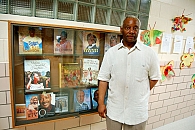One woman after another stood up and approached the front of the conference room in the city school district’s central office. Their schools had been recognized by the state’s education commissioner for dramatic improvement in student performance, and Superintendent Jean-Claude Brizard was extending his appreciation. The women were often accompanied by their assistant principals and several teachers. Within minutes, Brizard was flanked on all sides by women educators.
Out of the 21 principals who were honored that evening, Brizard called only two men to come up and meet him. It wasn’t because the men are less effective principals. It’s because they’re so scarce. And male teachers are even harder to find.
What’s happening in Rochester’s city schools is part of a state and national trend. And there is some debate over why it has happened, and what can be done about it.
The number of male elementary teachers, about 10 percent of all teachers nationwide, has sunk to the lowest point in decades, according to the National Education Association. The Rochester city school district had an enrollment of nearly 33,000 students in the 2007-2008 school year, with a total of 3,506 teachers. At the elementary level, only 16 percent of those teachers are men. The secondary level fares a little better, with 26 percent. And women principals outnumber men by nearly 3 to 1, because they typically come up through the ranks of the teaching pool.
“It is really unbelievable, but it’s absolutely true,” says Malik Evans, president of the city school board.
It would be better to have more men in the organization, says Joanne Giuffrida, chief of human resources for the city schools.
“Everyone agrees that we need more male teachers,” she says. “But finding them is the problem. They are just not there in large numbers. They’re not in the other school districts. And I think you’ll see that they’re not coming out of the colleges in large numbers, either.”
There are multiple reasons why fewer men are entering teaching, Giuffrida says. In this region, she says, population began to decline and the demand for teachers fell.
“The school-age population was coming down, and there was no point in going into teaching because, in this area at least, there were no jobs,” she says. “It didn’t matter which gender you were. The hiring dried up.”
And it stayed that way until the mid-1990’s, she says, when large numbers of teachers retired. Now, she says, the market has gone soft again.
This up and down in the demand for teachers is hard on men, Giuffrida says, particularly if they are the breadwinner in the family.
Starting salaries for new teachers fresh out of college have played a role in the gap between female and male teachers, too, says Giuffrida. New teachers without a master’s degree started at $38,700 in the city schools during the last school year.
It is a starting salary, Giuffrida says, that has traditionally appealed to women who become the second earner in the household.
“It is about the salary,” says Daile Cox, a math teacher at Wilson Foundation Academy and a former engineer.
But the biggest reason for the scarcity of male teachers has to do with what researchers have referred to as the “feminization” of public education.
“The research has been done many times, and the answers seem to always come up the same,” says Mary Skvorak, director of undergraduate elementary education programs at Nazareth College. “It’s gender politics.”
On the whole, men appear to be attracted to the subject matter, she says, but maybe not the classroom environment. More women, the research suggests, like being with children.
That doesn’t mean that men aren’t nurturing, Skvorak says, but it’s true that male teachers are rarer in the elementary grades, where the curriculum is more general. Males begin to appear in greater numbers starting in middle school, where the curriculum becomes subject-specific.
There is also, Skvorak says, a darker, less articulated concern that the public sometimes has about men in schools: they may be there for the wrong reasons.
“I think there is more sensitivity in our society to stranger danger with men and little children in schools,” she says. “But, of course, this is a fear that just does not have a basis in the reality.”
Skvorak doesn’t see an easy fix for the lack of males in the classroom.
“What can we do about it?” she says. “I’m the director of a college program and I don’t know that there is an answer. We have a hard time matching our few male student teachers with a male mentor teacher in the field. And it’s too bad, because the research shows that it improves the student-teacher’s chances of becoming a successful teacher.”
Bruce Finch teaches second grade at School 57. He’s says he’s more than just a teacher.
“As a male teacher working in the city school district, I’m the father image for many of them,” he says. “And being an African-American male, I am a role model for them, too. That’s why I wish there were more of us.”

